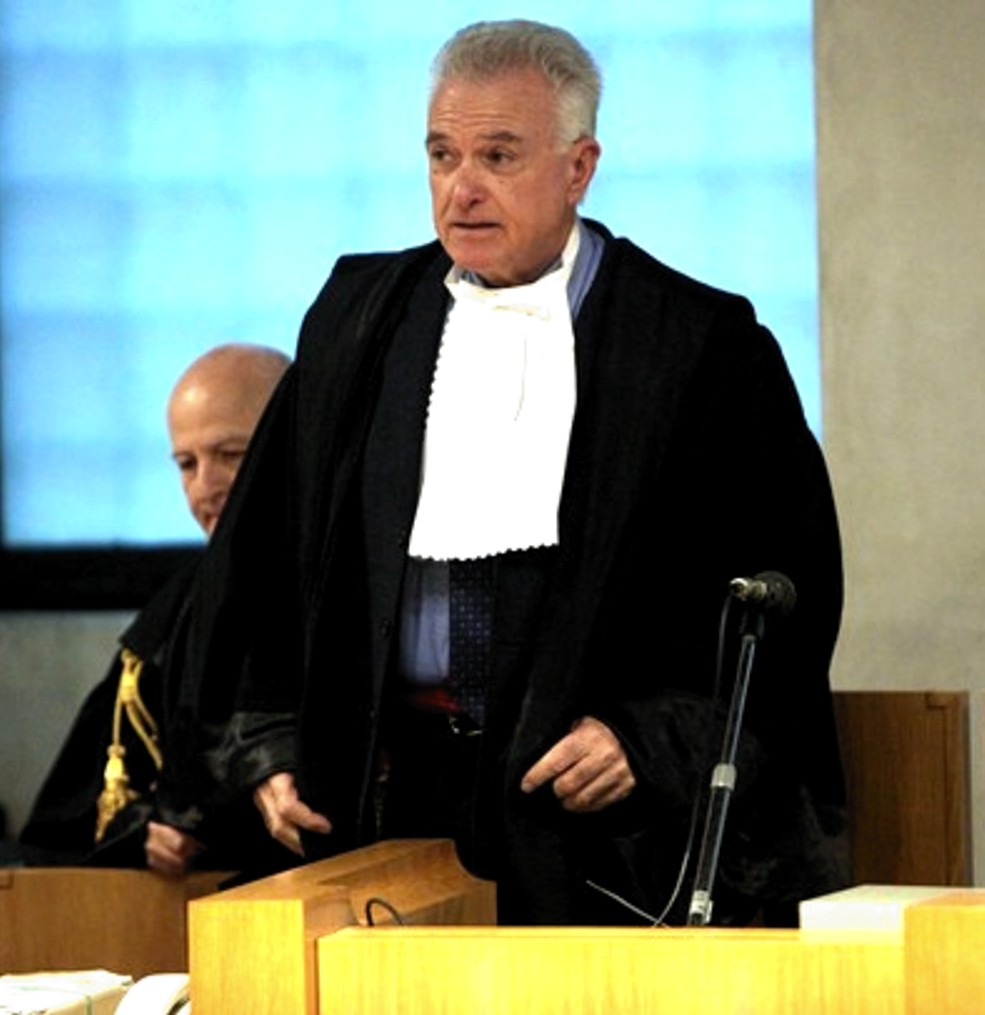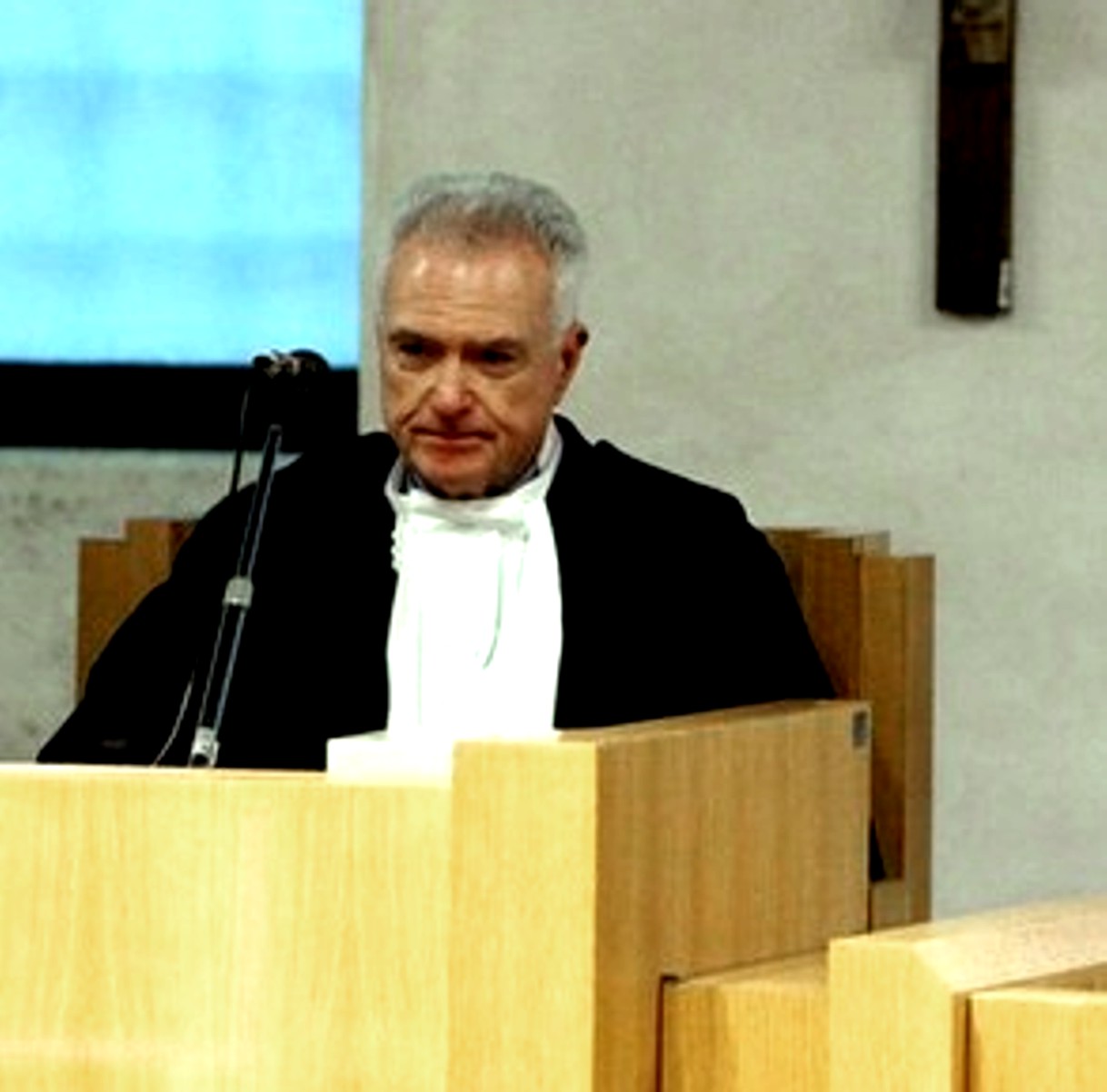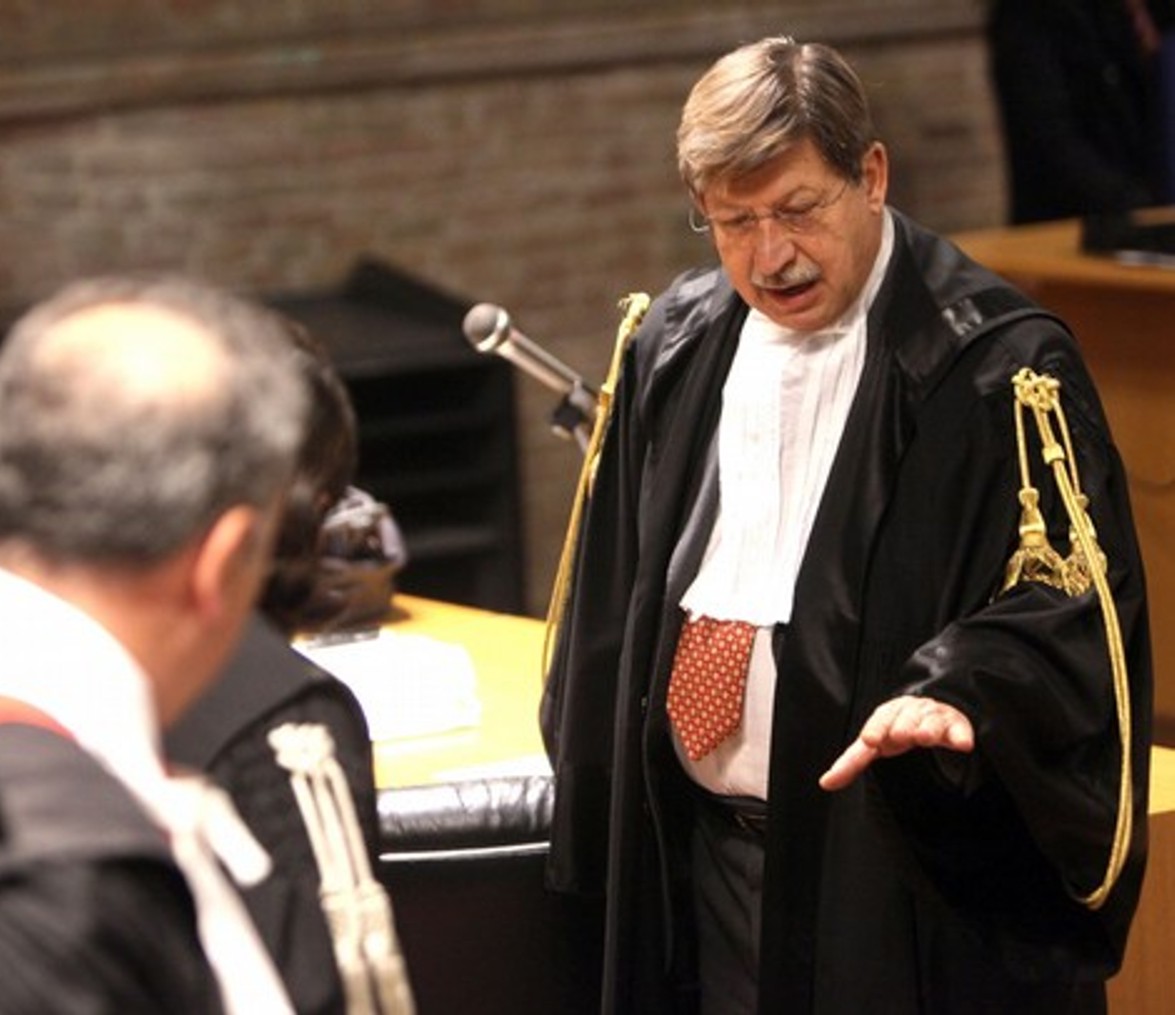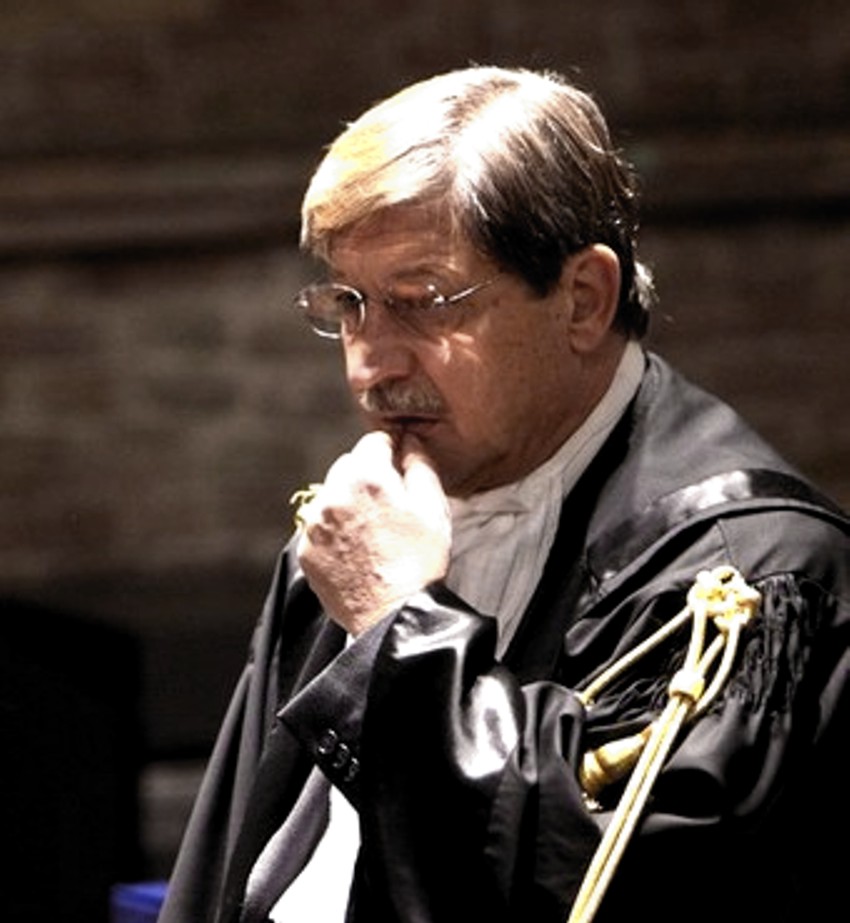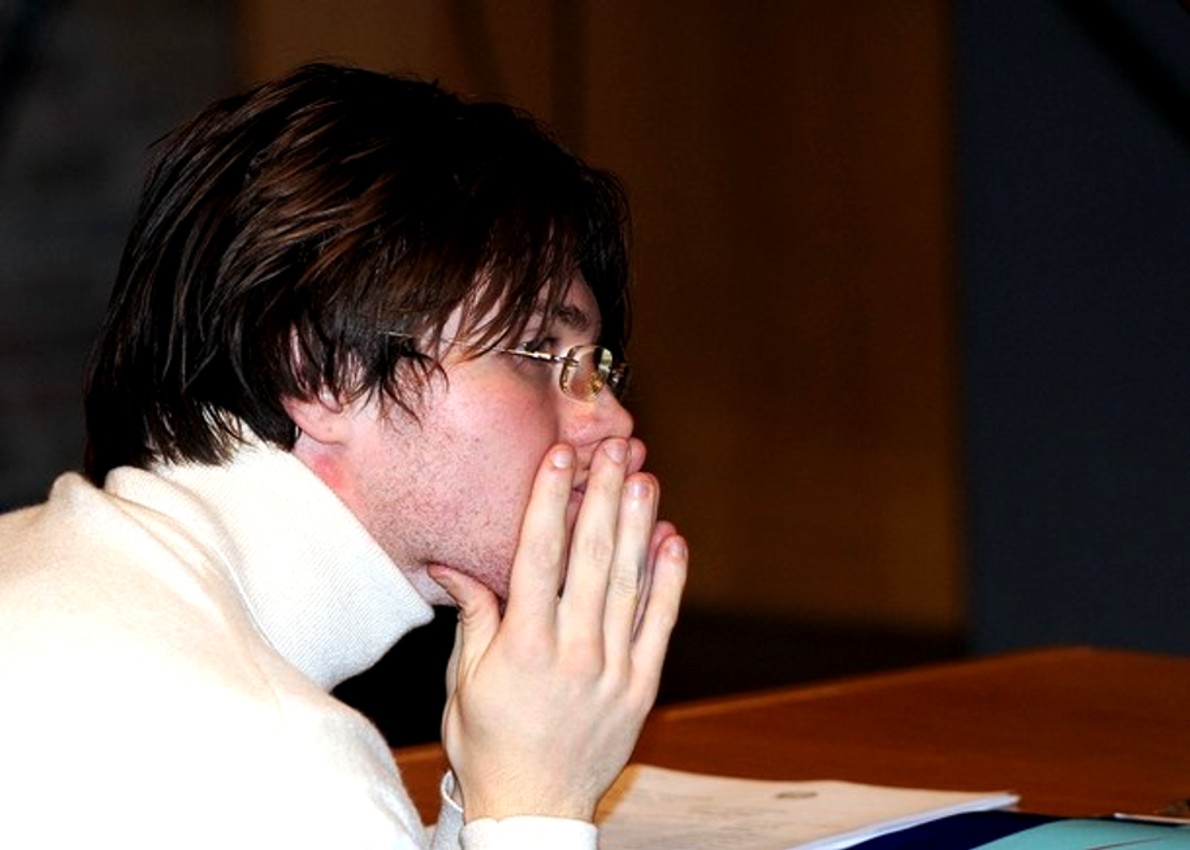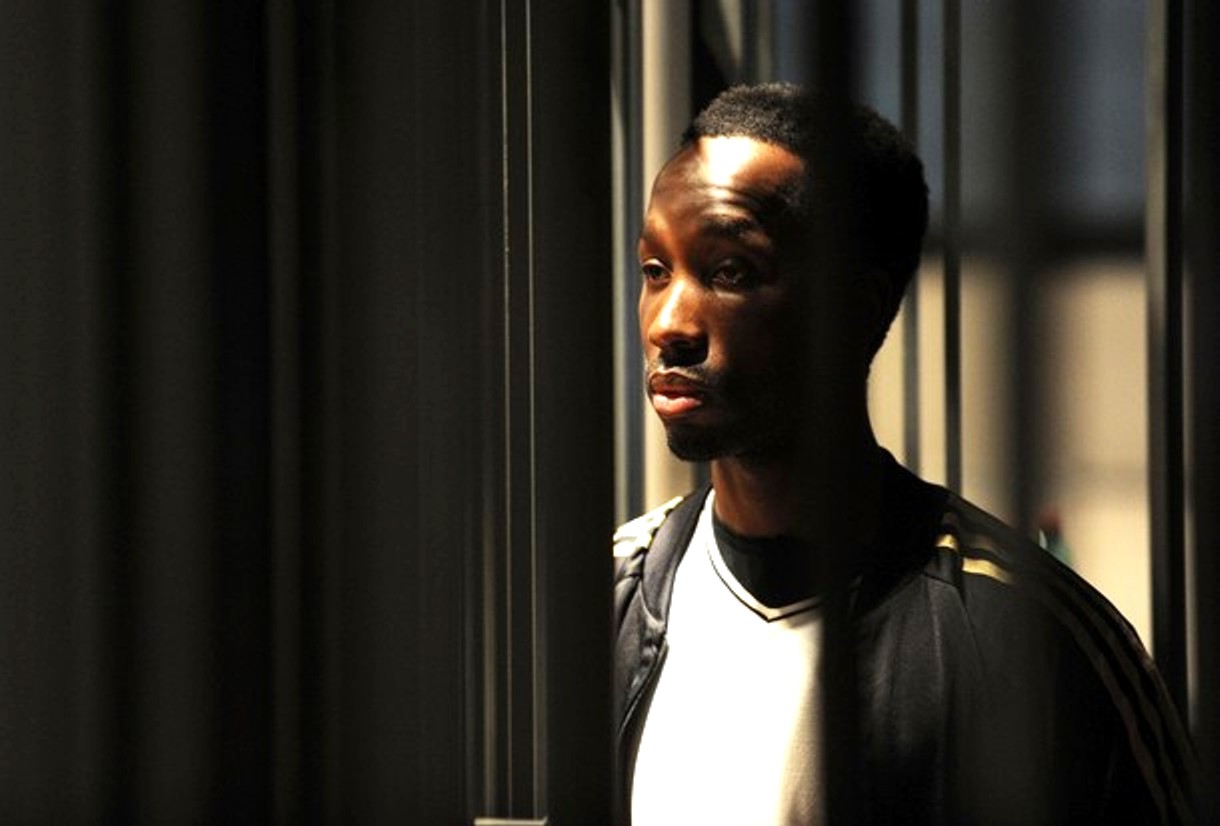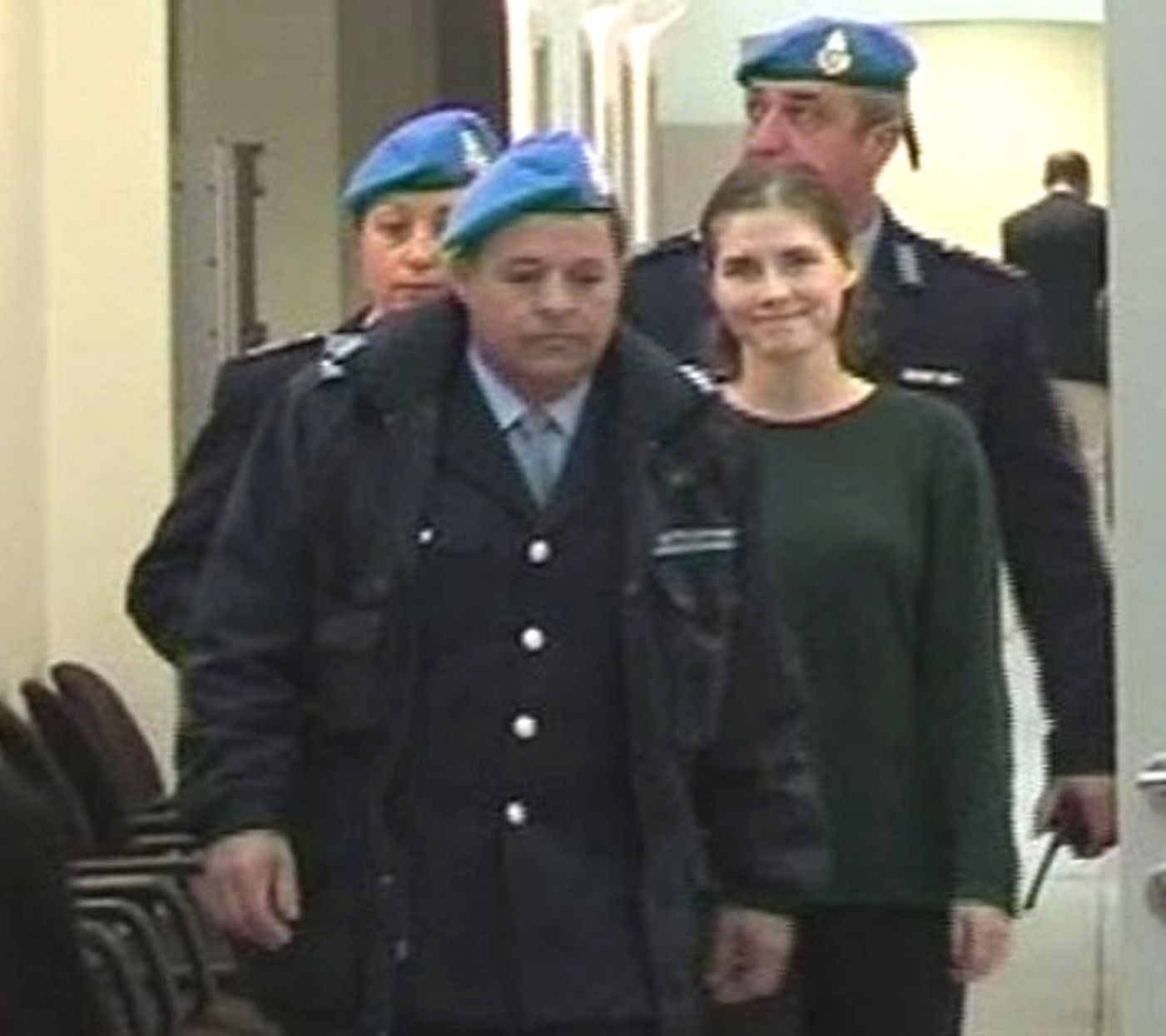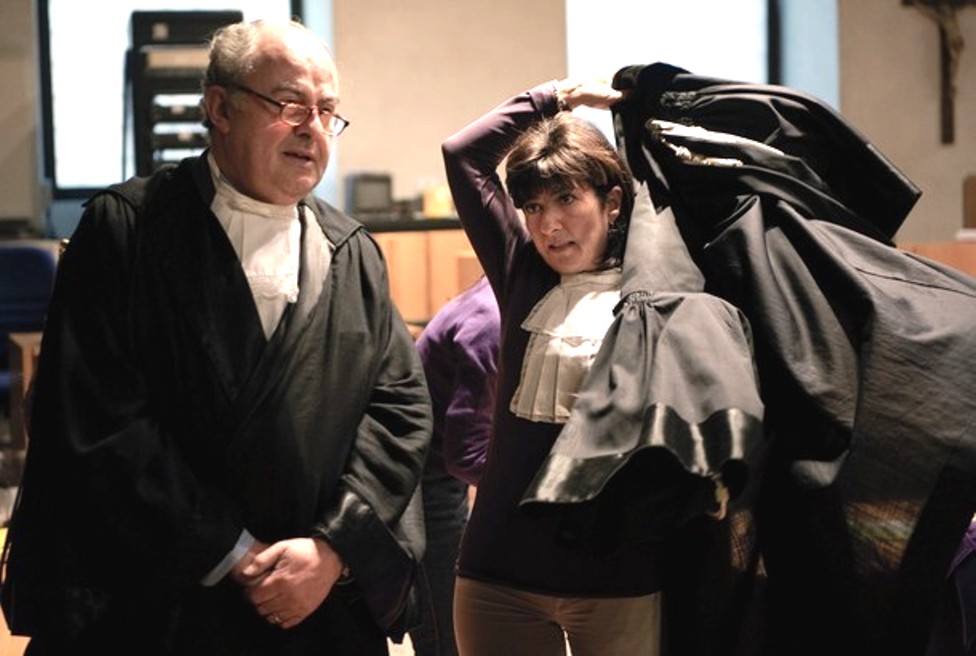
Category: Trials 2008 & 2009
Wednesday, November 24, 2010
1st Appeal Session: Appellant Amanda Knox Arrives In Appeals Court
Posted by Peter Quennell
1st Appeal Session: Appellant Raffaele Sollecito Arrives In Appeals Court
Posted by Peter Quennell
1st Appeal Session: Judge Claudio Pratillo Hellmann And Prosecutor Giancarlo Costagliola
Posted by Peter Quennell
Monday, November 22, 2010
Explaining The Massei Report: Motive In The Meredith Kercher Case And Its Addressing In The Report DRAFT
Posted by James Raper
superceded by revised post 12 april 2011
I have read the Massei Report which in the main I thought was excellent. He was incisive with his logic, particularly, though not exclusively, with regard to the staging of the break in and how that necessarily meant that Amanda was present at the scene when the murder was committed.
However, I thought that he was rather feeble in his coverage of the defendants’ motives as to the attack which led to this brutal murder. Perhaps he thought it better to stick with the indisputable evidence.
Since this pointed to a sex attack, he surmised that Guede had a go at Meredith first, and then - because the stimulation was too much for them - he was joined by Amanda and Raffaele. This works but does seem a bit weak. There were, to my mind, undoubtedly other factors at work, and it is these which I wish to address.
For instance, Massei asks, though he says we can not know, had Amanda egged Guede on as to the “availability” (my word, not his) of Meredith during or prior to their presence at the cottage?
Frankly the answer to that has to be “yes” since it is a bit difficult to figure out why Amanda and Raffaele would otherwise wish Guede to join them at the cottage. I doubt that Amanda and Raffaele would have wanted Guede around if they were just going there to have an innocent cuddle and sex and to smoke cannabis, as Massei implies.
The evidence is that Raffaele hardly knew Guede and in the presence of Amanda was very possessive about her. If he had known of Guede’s interest in Amanda he would have been even less keen to have Guede around.
Also, if all was so innocent beforehand, then why would Guede have tried it on with Meredith and then pressed the situation in the face of her refusal to co-operate, knowing that there were two others there who could have come to her assistance?
The answer is of course that Guede knew full well in advance that there would be no problem with Amanda and Raffaele. He had been invited there and primed to act precisely in the way he did, at least initially. Why? Well there is plenty of evidence as to why Amanda, in her mind, may have been looking for payback time on Meredith. Come to that later.
What does not get much attention in the Massei Report, other than a terse Not Guilty at the end, is the matter of Meredith’s missing rent money and credit cards and whether Amanda and Raffaele stole them.
It is as if the Judge (well, the jury really) felt that this was a trivial issue that brought nothing much to the case and thus it was not necessary to give it much attention. And indeed there is no summation of or evaluation of that evidence.
Now that does surprise me. Of course there may have been some technical flaw with the charge and the evidence. But in the absence of any comment on this then we do not know what that may be. What I do know is that the matter, if proven, is not trivial.
A theft significantly ups the stakes for Amanda and Raffaelle just prior to the murder and produces a dynamic, which, threaded together with a sexual assault, makes for a far more compelling scenario to murder.
It also leads one to conclude that there was a greater degree of premeditation involved : not premeditation to murder but as to an assault, rather than the more spontaneous ” let’s get involved” at the time of the sex attack as postulated by Massei. An Italian lawyer could tell us whether this would have added extra time on to their sentence. It is worthy of consideration.
What is the evidence? What evidence was before the court? I do not have access to trial records, only what I have read about the case in the book “Darkness Descending” and on the True Justice for Meredith website. Therefore I stand to be corrected if I misrepresent the evidence or if my interpretation of it does not met the test of logic.
There were two lay witnesses who were compelling in the trial. The first was Filomena Romanelli, the flatmate and trainee lawyer. If there was anyone who was going to ensure that the rent was paid on time, it would have been her.
She gave evidence that the rent being due very soon she asked Meredith about her contribution of 300 euros and was told by Meredith that all was OK because she had just withdrawn 200 euros from her bank. Filomena assumed from Meredith’s reply that the balance was already to hand.
Is there a problem with this evidence? Is it hearsay and thus inadmissible under Italian law?
Perhaps it is not enough by itself because of course had Meredith not in fact withdrawn the money from her bank, or sufficient funds to cover the stated amount, then that would be a fatal blow to that part of the theft charge. Her bank manager was summoned to give evidence, essentially to corroborate or disprove Filomena’s testimony.
I do not know what exactly that evidence was. One would assume that at the very least it did not disprove her testimony. Had it done so that would, as I have said, been fatal. It is also unbelievable that Massei would have overlooked this in the Report. I am assuming that Meredith did not tell a white lie and that the bank records corroberate this.
There may of course be an issue of timing as I understand that the bank manager told the court that transactions at a cash machine are not necessarily entered on the customer account the same day . However that does not seem to me to be significant.
One must also think that the bank manager was asked what other cash withdrawals had been made if the credit cards were taken at the same time as the money. I understand that there is of course a caveat here: my assumptions in the absence of knowing exactly what the bank manager’s evidence was.
It would be useful also to know how and when the rent was normally paid. It sounds as if it was cash on the day the landlord came to collect.
We do know that the police did not find any money or Meredith”˜s credit cards. Had Meredith, a sensible girl, blown next month’s rent on a Halloween binge? Unlikely. So somebody stole it. Again, just as with the fake break in, when according to Amanda and Raffaele nothing was stolen, who and only who had access to the cottage to steal the money? Yes, you have guessed it. Amanda, of course.
Does the matter of missing rent money figure anywhere else? There is the evidence of Meredith’s phone records which show that she rang her bank late on the evening of her murder just prior to the arrival of Amanda, Raffaele and Guede.
Why did she do this? What do you think? What is the first thing you do when you discover that your credit cards are missing? Obviously have a good look round. Then you ring your bank to put a stop on them. It may have been that she was not actually able to do that at that time of night. But worthy of further investigation.
The missing money also figured in the separate trial of Guede. He made a statement which formed the whole basis of his defence. Basically this was that he had an appointment with Meredith at the cottage, had consensual foreplay with her and was on the toilet when he heard the doorbell ring etc, etc.
What he also added was that just before all this Meredith was upset because her rent money had disappeared and that they had both searched for it with particular attention to Amanda’s room. Now why does Guede mention this? Remember this is his defence. Alibi is not quite the right word. He had plenty of time to think about it or something better.
His defence was moulded around (apart from lies) (1) facts he knew the police would have ie no point denying that he was there or that he had sexual contact with Meredith : his biological traces had been left behind, and (2) facts known to him and not to the police at that stage ie the money, which he could use to make his statement as a whole more credible, whilst at the same time giving the police a lead. He is shifting the focus, if the police were to follow it up, on to the person he must have been blaming for his predicament, Amanda.
If all three, Amanda, Raffaele and Guede, went to the cottage together, as Massei has it, then Guede learns about the missing rent money not as referred to in his statement but because Meredith has already discovered the theft and worked out who has had it and challenges Amanda over it when the three arrive.
Perhaps this is when Guede goes to the toilet and listens to music on his Ipod. After all he is just there for the sex and this is all a distraction.
I expect, however, that Guede’s “evidence” was not a factor in the jury’s consideration. Neither Guede’s lawyers nor those for Amanda and Raffaele wanted Guede to testify at the trial, for obvious reasons Without Guede testifying his statement would have been objectionable if not inadmissable.
I would have thought, though, that the prosecution could have brought him in as a witness, with the agreement of the judge, to testify as to the missing rent money only. Guede and his lawyers might well have agreed to this on the basis that such limited questioning would not have incriminated him further and might well have had a beneficial effect in his appeal. Convicted criminals often give evidence in court. What weight is attached to the evidence of a convicted criminal is a matter for the jury.
As the prosecution have appealed Amanda’s and Raffaele’s sentences, asking for lengthier terms, could they produce Guede now? I don’t know.
When were the money and credit cards stolen? According to Amanda and Raffaele they spent Halloween together at Raffaele’s and the next day went to the cottage. Meredith was there. Meredith left at about 1pm to spend the evening with her friends and Amanda and Raffaele left at about 3pm.
This is according to Amanda and Raffaele of course but probably likely because if the money had already been stolen Meredith may likely have known with different consequences for everyone. So Amanda and Raffaele could have stolen the money and credit cards after she left - the day of her murder.
Incidentally Filomena testified that Meredith never locked the door to her room except on the occasions she went home to England. Meredith was a very trusting girl.
What motive had Amanda for wanting the money apart from the obvious one of profit? There are numerous plausible motives.
To fund a growing drugs habit which she shared with Raffaele? Not an inconsiderable expense for a student. Both Amanda and Raffaele explained their confusion and hesitancy as being due to the fact that they had been going rather hard on drugs.
To embarrass Meredith vis a vis her landlord and the other flatmates? Because Amanda’s own financial circumstances were deteriorating and to fund her own rent contribution? She was probably about to be sacked at Lumumba’s bar and to add insult to injury would likely be replaced by Meredith. In fact Meredith was well liked by all whereas Amanda’s star was definitely on the wane.
That must have irked Amanda. Filomena testified that Meredith and Amanda had begun to have issues with each other towards the end.
With Meredith’s money both Amanda and Raffaele could have afforded something a little stronger than the usual smoke and I speculate that they spent the late afternoon getting stoned. Did they use the credit cards? If they did then it was probably small cash withdrawals but the likelihood is that they did not as in the limited time prior to Meredith’s death they had the use of her ready cash, and after her death the safer thing was to destroy them.
Of course Amanda was still an employee of Lumumba and she would have to turn up that evening for work, but perhaps she no longer cared all that much about the consequences.
Again I speculate that she and Raffaele met Guede before she was due at work, discussed Meredith’s “availability” and Amanda, Raffaele and Guede agreed to meet up on the basketball court at Grimana Square between 11 and 11.30pm, by which time Amanda would expect to have got away from the Le Chic bar.
What else did Amanda and Raffaele have in mind when arranging the meeting or when thinking about it afterwards? Guede was of course thinking about sex and that Amanda and Raffaele were going to facilitate an encounter with Meredith later that evening.
However Amanda and Raffaele had something else on their minds. The logic of their position vis a vis Meredith cannot have escaped them. They had taken her money and credit cards whilst she was out. Had she not already discovered this fact then she would in any event be back, notice the money and credit cards were missing and would put 2 and 2 together.
Very probably Meredith had not already discovered the theft because, spending a quiet time with friends, she had no cause to use her credit cards. What would happen? Who would she tell? Would she call the police? How are they going to deal with this? Obviously deny it but logic has its way and the situation with or without the police being called in would be uncomfortable.
They decided to turn the tables and make staying in Perugia very uncomfortable for Meredith. Now the embarrassing, for Meredith, sexual advances from Guede were going to be manipulated by them in to a sexual humiliation for Meredith.
Meredith was not going to be seriously harmed but as and when they were challenged by Meredith over the missing money, as inevitably they would be, she was to be threatened with injury or worse. Knives come in useful here.
She would likely then give up her tenancy at the cottage, perhaps leave Italy. Whether that looks like the probable and likely outcome I leave you to judge, but just how much of this would be precise and careful planning given, as seems likely, that Amanda and Raffaele were going hard on the drugs?
They were not in a position to act any earlier than they did. They knew that Meredith was away with her friends and probably would not come home until much later. Amanda was expected at Lumumba’s. Guede was not available until the pre-arranged time.
In the event Amanda did not have to go to work. She and Raffaele were at a loose end until the time of their pre-arranged meeting with Guede. They got to the basketball court early. They had to wait for him. They could not ring him as he did not have a phone.
We know Amanda and Raffaele were on the basketball court (some of the time if not all of the time) between 9.30 and sometime just before 11.30pm. This is because of the evidence of a Mr Curatolo, the second compelling lay witness. He testified to seeing Amanda and Raffaele having heated arguments, and occasionally going to the parapet at the edge of the court to peer over.
What were they looking at? Go to the photographs of Perugia on the True Justice for Meredith website and you will see. From the parapet you get a good view of the gates that are the entrance, and the only entrance as I understand it, to the cottage.
So why the behaviour observed by Mr Curatolo? They may have been impatient waiting for Guede to arrive. Were they actually to go through with this? One might speculate that Raffaele was not actually as keen on it as Amanda.
Was Meredith at home, alone, and had she found the money was missing and had she called the police or tipped off someone already? Who was hanging around outside the entrance to the cottage and why?
There was, apparently, a car parked at the entrance, a broken down car nearby with the occupants inside awaiting a rescue truck, and the rescue truck itself, all present at different times. Amanda and Raffaele did not wish to be observed going through the gates with these potential witnesses around.
We, of course, cannot know for certain what went on in the minds of Amanda and Raffaele and account for much of their movements between the time of them leaving the cottage at, they say, 3pm and their departure from the basketball court at around 11.30pm. It has to be speculation but there is a logical consistency to the above narrative if they had stolen Meredith’s money and credit cards earlier that day, and their meeting up with Guede just before 11.30pm does not look like a co-incidence.
From there on in to the inevitable clash between Amanda and Meredith over the money and credit cards, the threats and intimidation by Amanda and Raffaele to scare her, the sexual assault as part of that, and the tragic death of Meredith.
In a civil case in this country, the standard of proof is “the balance of probabilities” rather than the higher standard of (to paraphrase) “beyond reasonable doubt” in a criminal case.
If my earlier caveat about the bank manager’s evidence not disproving that Meredith had withdrawn her money is unnecessary then, at the very least, on the balance of probabilities, it is proven that Meredith had that money, and the credit cards, and that Amanda and Raffaele had stolen them from her. Some might think (I do) that it is proven on the higher standard too.
It is a shame that the Massei court did not consider and evaluate all of the evidence before it.
It did not need to fear that by doing so it may have been including something which others might consider eminently appealable, since the evidence and reasoning on which it did convict Aamanda and Raffaele of murder was sound and impeccable.
Addendum : There have been a great many useful comments on this post. As a consequence I accept that the scenario outlined above requires at least two modifications and these are in my last comment below.
Thursday, November 18, 2010
First Appeal Hearing Next Wednesday In Suggestive Absence Of Sollecito Lead Lawyer Giulia Bongiorno
Posted by Peter Quennell
The first appeal hearing next Wednesday 24 November will be technical or procedural.
The hearing to be presided over by by Appeals Judge Claudio Pratillo Hellman will cover the lawyers’ motions on evidence and witnesses.
If at the next hearing on 11 December those requests are disallowed (all of the Guede team’s requests during Guede’s appeal last December were disallowed) this level of appeal for Knox and Sollecito might be over within two months if we assume two hearings a week. .
Appeal Prosecutor Giancarlo Costagliola will be joined by main-trial prosecutors Manuela Comodi and Giuliano Mignini. This was a judge’s decision, and not Ms Comodi’s or Mr Mignini’s, and it was to ensure that many months would not be wasted mastering the complexities of the Massei Report and the further many thousands of pages of documents that make up the case.
The defence teams will consist of Giulia Bongiorno, Luca Maori and Donatella Donati for Raffaele Sollecito, and Luciano Ghirga, Carlo Della Vedova and Maria del Grosso for Amanda Knox. Ms Bongiorno is five months pregnant, and she has said that it is for this reason that she will not appear in court next wednesday.
Is this move a sign of something more to come?
During the trial last year, the prosecution hardly missed a beat and the pace was relentless. When it came time for the defense phase, it was slow and hesitant, some court days were canceled, and some of the defense presentation seemed decidely ad hoc.
Once last year Ms Bongiorno disappeared for weeks on end, ostensibly on parliamentary business, and later in the year she developed an attack of appendicitis at a key moment. That threw into question whether she would handle the end-of-trial defense summation - at the last moment, some part of it she did
She presumably isn’t liking this case very much. Her attempt amidst much publicity to have someone actually simulate Guede’s supposed climb through Filomena’s bedroom window was a total ignominious failure. And we have heard that the Sollecito family and defense team despise the Knox entourage and PR scheme with its incessant sliming of the Italian justice system and its main players in this case, which has done them nothing but harm.
Raffele Sollecito himself has still not provided Amanda Knox with a full alibi for the night (his last word was that she was out for four hours) and on the whole seems to show signs of pulling way from her rather than of associating himself with her any closer. They talked by phone a few days ago but the call was officially monitored and so we presume nothing significant was said.
The Knox defense might complain about no videotape or recording of Knox fingering Patrick, for which she was awarded an extra year in prison. But the unscheduled WITNESS interrogation of Knox did not require a recording - witnesses by the thousand are questioned by police daily all over the world (watch any crime show on TV) without a video recording being made.
Maybe it is just as well for Knox as she seemingly cracked because Sollecito made her crack - by calling her a liar in the next room, over their first alibi, and changing his own. Better not to have recorded that…
The mitigating factors that Judge Massei accepted that are being appealed against by the prosecution include whether Knox demonstrated some remorse by placing the duvet over Meredith after the attack - meanwhile apparently removing her cell phones and locking the door some minutes before Meredith finally succumbed.
They also include whether Knox instigated the attack on Meredith. Judge Massei concluded that Guede instigated it, but Mignini had argued that there was a payback element to the attack, which may have entered their minds the previous day (those AK messages to Meredith) or that same fateful night (Patrick’s message saying no need to come to work, one interpretation being that Amanda was on the point of being fired.)
On the demand for some retesting of the DNA, it is worth recalling that the defense experts were expected to attend the one time only testing of the DNA on the knife - but on that day despite weeks of advance notice they found “good” reason to be elsewhere.
On the demand for retesting of Sollecito’s DNA on the bra clasp, it was pressed in hard and there is zero sign that any contamination had taken place - here again. the defense played a seeming trick. The Rome labs realised within hours of their first crime scene search that the bra clasp was still back in Meredith’s room, and weeks went by before the investigators and representatives of the defense could all be there to collect it.
The many contradictory albis, the various witnesses, the luminol evidence, the post-attack behaviors, the possibilities of both Raffaele Sollecito and Rudy Guede at his second appeal, which is in December, turning into wild cards?? Not a pretty sight for Amanda Knox’s defense.
Can they get pregnant too? No doubt they wish that they could.
Monday, November 08, 2010
Another In Seeming Never-Ending Disasters For Hapless Knox Campaign
Posted by Peter Quennell
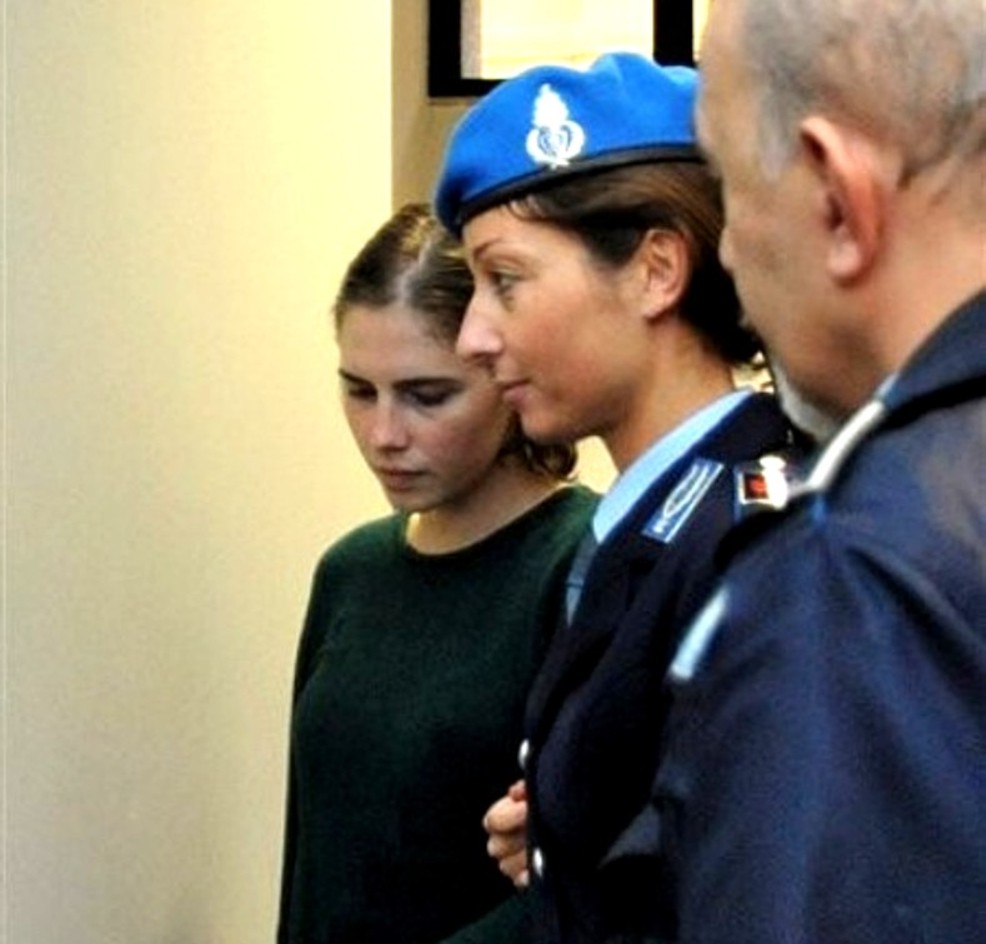
Apparently xenophobia and sliming and serial misconstruing of the evidence isnt working. The Italian authorities continue to be relentless and unblinking.
In court today, Amanda Knox was indicted by the judge and she WILL stand full trial next May for calunnia. This first report on the BBC News website as follows.
American student Amanda Knox is to face trial for slander after saying police beat her during questioning over the killing of Briton Meredith Kercher.
A judge made the decision at a closed indictment hearing in Perugia, Italy.
Knox, 23, told the judge she never intended slander and was just trying to defend herself, her lawyer said.
Ann Wise of ABC News adds this.
American student Amanda Knox was indicted for a second time by an Italian court today, this time for allegedly slandering Italian police for saying they were abusive when they interrogated her for the murder of her roommate.
Knox, who was convicted last year of murdering Meredith Kercher and sentenced to 26 years in prison, stood up in court and made what Italian legal officials call a “spontaneous statement” before the judge’s ruling.
“I have always tried to defend myself. I never wanted to offend or slander anyone,” Knox said in Italian.
Nevertheless, preliminary hearing Judge Claudia Matteini indicted Knox, 23, for slander.
The charge refers to Knox’s testimony during her murder trial that Italian police were rough with her when they interrogated her overnight just days after Kercher’s body was found in a pool of blood in the house they shared.
She claimed the officers yelled at her, discouraged her from calling a lawyer and cuffed the back of her head. The 12 officers named in the slander complaint have denied being abusive to Knox.
At the end of the long interrogation, Knox signed a statement in which she said she had a confused dream-like recollection of being in the house and hearing Kercher scream, effectively placing her on the scene of the crime.
Knox’s lawyer Carlo Dalla Vedova said Knox was “saddened” by the decision.
Another lawyer for Knox, Maria Del Grosso, told reporters that “for Amanda this (interrogation) was the genesis for her homicide accusation. She is very frustrated and obviously disappointed, but she knows that today’s was only a preliminary hearing and the truth was not ascertained today. Let’s hope it is when the case is debated because there was something that went wrong that night.”
Knox was driven into the courthouse in a police van with darkened windows. The hearing was closed to the public, but photographers were able to get a glimpse of her in the courtroom hallways. Looking thinner and drawn, Knox wore a dark green sweater and black pants, her hair is a jaw-length bob.
Before the hearing, Knox’s stepfather Chris Mellas told ABC News that “Amanda is doing better. She is rightfully angry about the slander accusations, and told me she was going to speak out in court this morning. She told me she wanted to tell them that she sees police interrogations shown on TV all the time, and would like to know why her interrogation was not recorded or videotaped.”
But according to her lawyers, she limited her statement to saying she was just defending herself and did not want to offend.
Knox will go to trial for slander on May 17, 2011 before a single judge, Cecilia Bellucci. Matteini said the case needed to go to trial to resolve some formal technical matters, and to debate the accusations, possibly with witnesses.
The lawyer for eight of the police officers, Francesco Maresca, said that the “framework of the request for an indictment was confirmed, and now we await the debate.”
Conviction of the charge could add as much as six years to Knox’s prison sentence.
Again, this is the nexus of Amanda Knox’s accusation against poor Patrick Lumumba who spent two terrifying weeks in Capanne Prison and later lost his business when the customers fled.
Whatever else she may be, Knox does seem to be a serial blamer of others. Blaming the cops for her blaming Patrick, Knox seemed to us to think, was an easy way out.
Italian reports say that she seemed to be scowling or sour or very serious or depressed (no mention of nervousness) and that she had put on a few pounds.
Friday, October 29, 2010
Kercher Family Lawyer Francesco Maresca Confident Appeals Will Fail And Justice Will Prevail
Posted by Peter Quennell
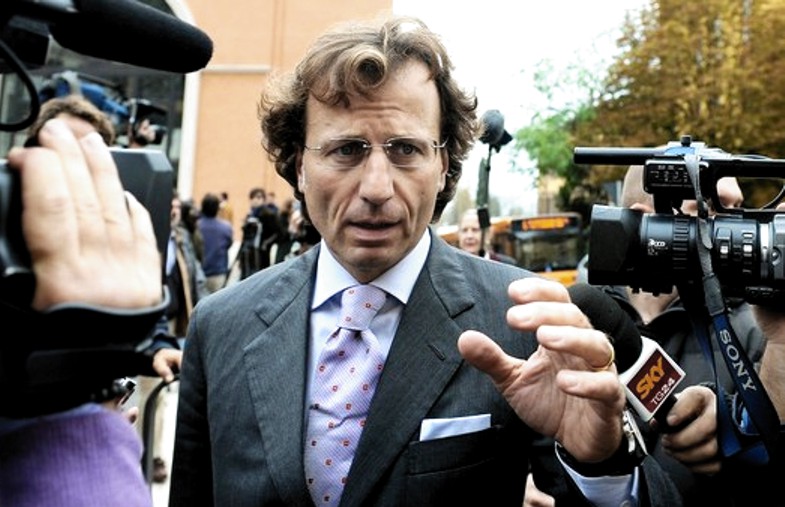
This excellent interview of Mr Maresca by Leonardo Molinelli just appeared in Canada Corriere.
The interview is similar to several others Mr Maresca has just given in Italy. Mr Maresca shows in all of them that he is very confident about the defense appeals not succeeding in any dramatic way.
Justice will be served in Kercher case
“The investigation was carried out very well”: lawyer
By Leonardo N. Molinelli
There’s less than a month to go to the start of the appeal process for the murder of 20-year-old American student Meredith Kercher. The next phase will begin on Nov. 24, which should establish the guilty parties in the death of Kercher, who was killed in Perugia, Italy between Nov. 1 and 2 of 2007.
Charged with first-degree murder, sexual assault, and theft is 26-year-old Amanda Knox and 23-year-old Raffaele Sollecito with whom Knox was having a relationship.
The other person facing charges ““ Rudy Guede from the Ivory Coast ““ will not be part of the process since he has already been condemned to 30 years [reduced to 16 at first appeal] at a summary procedure. He will face the Court of Cassation (appeals) for final sentencing [in December].
All three of the accused have always declared their innocence and the upcoming process promises to be controversial and sensational. The defence for Sollecito and Knox, in fact, has requested access to all forensic investigation from the Court of Cassation.
They’re requesting the analyses of all the principal exhibits, maintaining that the two were not present at the murder scene and thereby placing the blame squarely on Guede.
“The Kercher family has taught the world the dignity of silence.”
With these words, the family’s lawyer Francesco Paolo Maresca outlines the trial that went beyond the usual standards in legal battles in Italy, moving from the courtrooms to TV and newspapers.
Corriere Canadese/Tandem recently spoke to Francesco Paolo Maresca about the trial.
Has there been any new developments since the preliminary sentencing and the appeal?
“No, let’s say that the defence requested the appeals court for a review of all forensic findings, following the defence line in the preliminary trial, in which they contested all the assessments.”
Accusations that were discredited with the preliminary sentencing.
“Yes, so much so that the preliminary sentence is based on all these laboratory results accepted as fully reliable in the presence of the parties, and no one ever contested anything on that basis.”
So what is the defence’s objective in this case?
“They’re requesting, in substance, the detailed analyses of all the main exhibits, therefore the bra hook containing Sollecito’s DNA and the bathroom rug with Sollecito’s footprint.”
Do they intend to demonstrate the non-involvement of the two youths in the murder?
“They’re aiming to demonstrate the total non-involvement, unloading everything onto Rudy Guede.”
So Guede would have killed Meredith by himself while Amanda and Raffaele were in the wrong place at the wrong time?
“Actually, they say they were at Sollecito’s house after having smoked hash, made love, and woken up early the next morning.”
So they would have been connected to the crime scene as part of a conspiracy?
“They got there by coincidence based on test results. They say that the DNA on the bra isn’t Sollecito’s and if it were, it would have been found in other parts of the house, that the footprint on the rug isn’t Sollecito’s), that the DNA on the knife isn’t Knox’s, and so on.”
Instead, what are the facts as pieced together by the preliminary sentence?
“The facts pieced together would be a sexual attempt gone wrong, with a series of progressive and worsening knife wounds, with intimidation and threats and with three very serious wounds to the neck, of which one was fatal. We ““ and the sentencing acknowledges this ““ maintain that the facts cannot be viewed as a premeditated theft but as a crime of violence.
They probably attempted some sort of sexual game, Kercher refused, they threatened her, wounded her, blood spilled, and they panicked. Knox knew everyone so if they had called an ambulance or the police, they would have had to justify their presence, which is why they finished her off.”
So it wasn’t premeditated?
“There’s no premeditation. There is no premeditation. The event needs to be examined using the approach of a contingent situation, of the fear of being discovered, of the fear of making noise. Kercher screamed horribly from the pain, the simulation of a theft was to throw the research on the wrong track.”
America insists there were leaks in the Italian justice system, a conspiracy against Amanda, and so on. What impression did you get during this trial? Are there any deficiencies in this trial?
“The investigation was carried out very well, and forensic science and the police did a good job. There was just the one deficiency ““ and un-influential ““ of this blessed (bra) hook that was left behind and discovered 40 days later, but it was proven that it could not have been contaminated, using a series of technical valuations.
One must consider that 368 exhibits were gathered if I’m not mistaken, and above all we made an enormous commitment of deliberating for about a year (Editor’s note: January to December, 2009), which was very quick for Italian trials. Rudy Guede was examined with a summary procedure within a year of the act, and the other two to three years from the act, but with a deliberation that involved 170 witnesses and technical consultants.”
An exemplary trial considering that Italian justice system is often blamed for being slow.
“It gets blamed because they have completely different parameters and have juries and courts that dedicate themselves to a single trial ““ they begin and end that trial over three-to-four consecutive months, doing nothing else. In our system, the criminal court does this while the judges concurrently do another 20, 30 or 40.”
A difference in systems that could be the reason for these accusations.
“They were astounded because we didn’t have daily hearings. We pointed out that having weekly hearings on Friday, Saturday, and Monday ““ that is three days out of six ““ is a very unheard of commitment. We all risked our families because we couldn’t see them anymore”¦”
The defence for this case is reminiscent of the one used for the Cogne case, with the victim who disappears from the media, and the likely murderer who becomes a celebrity of sorts.
“From a theoretic interpretation, I’d say that’s justice, and I must say that Meredith Kercher’s family taught the elegance of silence to the entire world. Because as the families of Knox and Sollecito organized foundations, associations, sought funds, gave interviews, requested political help, Meredith Kercher’s family remained under the radar screen notwithstanding the offers, including financial (ones).”
Monday, September 20, 2010
Explaining The Massei Report: All Judges, Lawyers And Witnesses At Trial Jan-Dec 2009
Posted by Storm Roberts
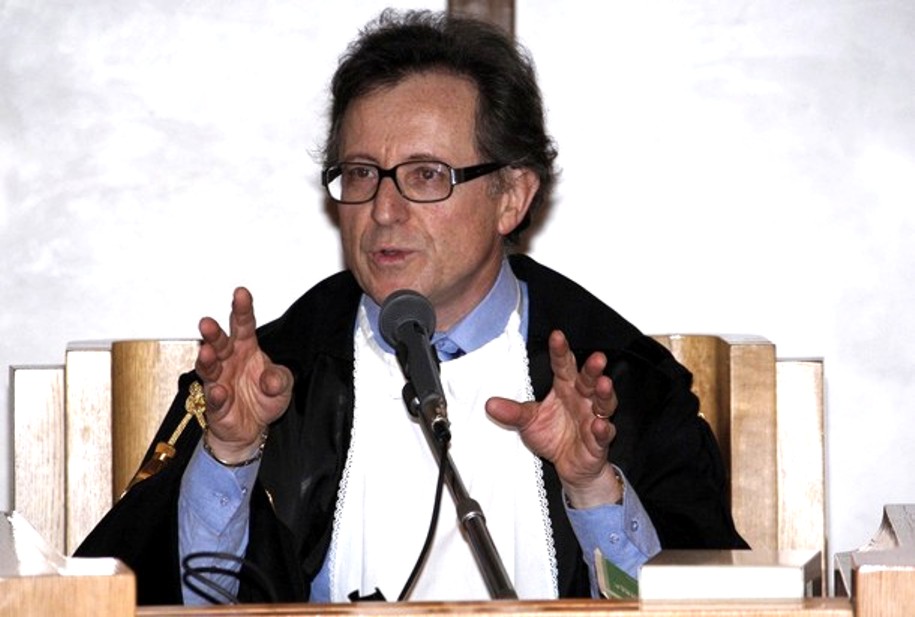
[Above: Dr Giancarlo Massei, the president of the Court]
Our intention with this new series of posts is to show how thorough the trial was, and how compelling the Massei Report on the grounds for the Knox-Sollecito sentence is.
At the beginning of the trial, the witness counts were considerable: approximately 90 for the prosecution, 60 for the civil plaintiffs, 90 for the defence of Raffaele Sollecito, and 65 for the defence of Amanda Knox.
However, a large number of witnesses for both Amanda Knox and for Raffaele Sollecito were removed from the witness listing. Thus the actual number of people testifying was lower than originally expected.
Here is a comprehensive list I have compiled, made by going through the Massei Report, picking out the witnesses, and noting what they testified about. If I had the information available, I have noted where a witness was specifically called by the defence of either of the then defendants.
Officers Of The Court
- Judges: Dr Beatrice Cristiani and Dr Giancarlo Massei, the president of the Court.
- Prosecutors: Public Ministers Dr Manuela Comodi and Dr Giuliano Mignini.
- Interpreter for Amanda Knox: Dr Anna Baldelli Fronticelli.
The Legal Teams:
- For the family of Meredith Kercher: Francesco Maresca and Serena Perna.
- For Diya “Patrick” Lumumba: Carlo Pacelli.
- For Aldalia Tattanelli (the owner of the house): Letizia Magnini.
- For Amanda Knox: Luciano Ghirga and Carlo Dalla Vedova.
- For Raffaele Sollecito: Giulia Bongiorno, Daniela Rocchi and Luca Maori.
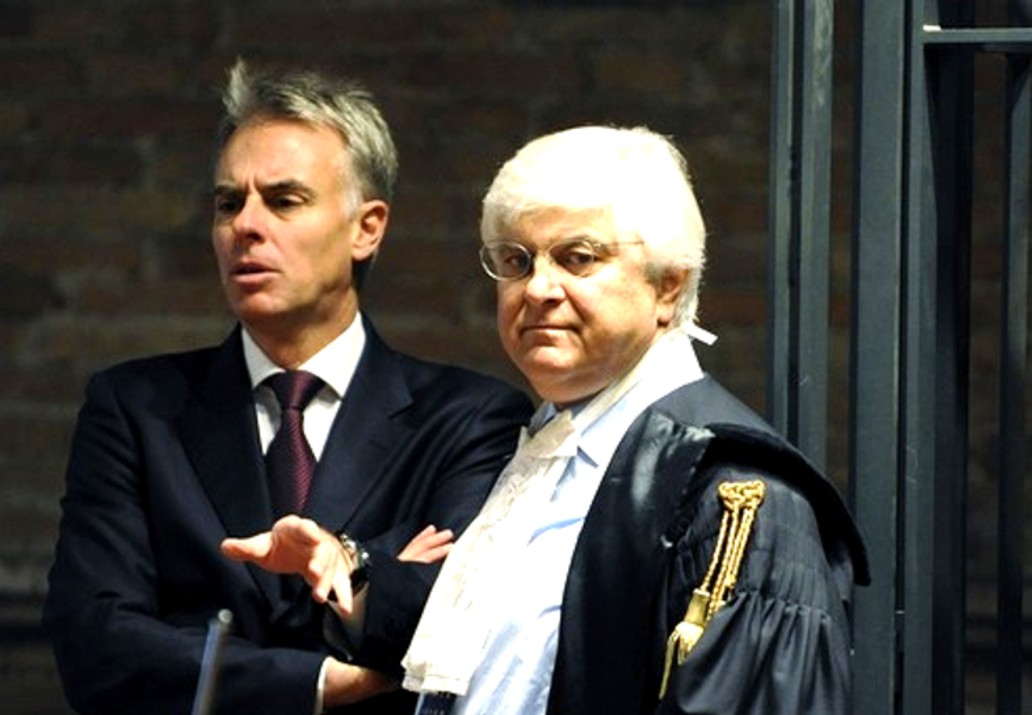
[above: Amanda Knox’s legal team]
Witnesses
The following is a list of witnesses and a brief note as to the evidence they presented. I am not detailing their arguments here, merely indicating the areas the witnesses were heard in. For full details of the evidence and the court’s arguments please read the Massei Report in full and the summaries coming up.
- Amanda Knoxtestified while not under oath at the request of her defence and the legal team representing Diya Lumumba. Her testimony was heard on 12th and 13th June 2009. Raffele Sollecito made a couple of interventions from his seat beside his three lawyers, but he did not get up on the stand.
- Mrs. Elisabetta Lana and her son, Alessandro Biscarini. They discovered two mobile phones, both belonging to Meredith Kercher (one was registered to Filomena Romanelli, Meredith’s flatmate), in their garden at Via Sperandio.
- Dr. Filippo Bartolozzi - at the time Manager of the Department of Communications Police for Umbria - Dr. Bartolozzi received the mobile phones from Mrs Lana, the first at approximately 11.45 to 12.00hrs on 2nd November 2007, the second at approximately 12.15 to 12.20 hrs. He traced the first phone to Filomena Romanelli and, at noon, despatched two officers to her address to investigate why her phone was in Mrs. Lana’s garden.
- Inspector Michele Battistelli and Assistant Fabio Marzi - the two officers despatched by Dr. Bartolozzi. They arrived at 7 Via della Pergola at a little after 12.30 hrs - they found Amanda Knox and Raffaele Sollecito sitting outside the house. They gave evidence about the circumstances leading up to the discovery of Meredith’s body and with regards to securing the scene whilst awaiting the Carabinieri and Scientific Police.
- Filomena Romanelli who was Meredith’s flatmate gave evidence regarding the phone she had lent to Meredith. She also detailed when she had moved into the flat at 7 Via della Pergola and the living arrangements. She told of her plans for the 2nd November and how a worrying phone call from Amanda Knox led to her calling her back and returning to her home earlier than planned. A key point of Ms. Romanelli’s evidence was her disagreement with Amanda Knox over when Meredith locked her door - Ms. Romanelli stated that Meredith had only once locked her door and that was when she had returned to England for a few days.
- Paola Grande, Marco Zaroli and Luca Altieri - the other young people who were at the property when Meredith’s body was discovered. Mr. Altieri broke down the door to Meredith’s room.
- Laura Mezzetti - the fourth flatmate in the upstairs flat at number 7 Via della Pergola. She testified with regards to the living arrangements and also that Amanda Knox is an early riser, a “morning person”.
- Robyn Butterworth, Amy Frost, Sophie Purton and Nathalie Hayward - Meredith’s friends from England. They testified as to when they last saw Meredith and described the behaviour of Amanda Knox and Raffaele Sollecito at the Police Station in the evening of 2nd November 2007. They also testified that Meredith had no plans after returning home at around 21.00 hrs on 1st November other than to study and have a rest as they had been out late the previous night and believed that they had classes the next day. Meredith’s friends did not know of Rudy Guede and had not heard Meredith mention his name.
- Giacomo Silenzi, one of the young men living in the flat underneath Meredith’s flat. He was Meredith’s boyfriend.
- Stafano Bonassi, Marco Marzan and Riccardo Luciani the other tenants of the downstairs flat. Along with Mr. Silenzi they testified as to the the interactions between themselves and the girls upstairs, the gatherings they held, the fact that Rudy Guede was known to Amanda Knox. They testified as to Rudy Guede’s actions at their house. They gave evidence of having met or known of Raffaele Sollecito and his relationship with Amanda Knox.
- Giorgio Cocciaretto a friend of the young men in the downstairs flat testified with regards to knowing Rudy Guede through playing basketball and having seen him at the 7 Via della Pergola house when both Meredith and Amanda Knox were present.
- Rudy Guede availed himself of his right not to participate in the trial of Amanda Knox and Rafaelle Sollecito. Judge Massei details Rudy Guede’s involvement based upon the evidence available in order to complete the reconstruction of events of 2nd November as he was charged alongside Amanda Knox and Raffaele Sollecito.
- Marta Fernandez Nieto and Caroline Espinilla Martin - two young ladies living in the flat above Rudy Guede, they testified than on the night of 31st October they had been in the presence of Rudy Guede and that the only girl they saw him dance with was a “blonde girl with long smooth hair”.
- Gioia Brocci from the Questura of Perugia who testified with regards to a trail of shoe prints leading from Meredith’s room to the exit of the flat getting fainter as they went. Ms. Brocci also testified as to the lack of signs of climbing on the wall below Filomena Romanelli’s window. She also collected evidence from the bathroom next to Meredith’s room.
- Sergeant Francesco Pasquale testified as to the possibility of breaking into the flat though the window in Filomena Romanelli’s room. Sergeant Pasquale was a consultant for the defence.
- Maria Antonietta Salvadori Del Prato Titone, Paolo Brocchi, Matteo Palazzoli and Cristian Tramontano testified with regards to previous incidents involving or possibly involving Rudy Guede.
- Edda Mellas , Amanda Knox’s mother. She testified as to communications with her daughter on the 2nd November amongst other things.
- Antonella Negri a teacher at the University who taught Amanda Knox and who testified as to her diligence as a student.
- Francesco Sollecito, father of Raffaele Sollecito. He testified as to his son’s character and about his communications with his son. He also spoke of his son’s relationship with Amanda Knox.
- Antonio Galizia, Carabinieri station commander in Giovinazzo, the Sollecito family’s home town. He testified that in September 2003 Raffaele Sollecito was found in possession of hashish.
- Jovana Popovic testified as to the presence of Amanda Knox at Raffaele Sollecito’s home at two points in time on the evening of 1st November 2007.
- Diya “Patrick” Lumumba was Amanda Knox’s employer at “Chic”. He testified that he has sent her a text message excusing her from work on the evening of 1st November.
- Rita Ficcara Chief Inspector of the State Police - to whom Amanda Knox delivered a written statement composed whilst she was awaiting to be transferred to Capanne Prison.
- Antonio Curatolo - Mr. Curatolo testified as to having seen Amanda Knox and Raffaele Sollecito at the basketball court in front of the University (the Piazza Grimana) in the evening of 1st November 2007.
- Maurizio Rosignoli - who runs a kiosk in the Piazza - testified with regards to the timing of buses at the Piazza Grimana thus corroborating times in Mr. Curatolo’s evidence.
- Alessia Ceccarelli - who worked managing Mr. Rosignoli’s kiosk - gave evidence as to Mr. Curatolo’s presence in the Piazza.
- Marco Quintavalle, who runs the shop “Margherita Conad”, testified he had seen Amanda Knox at 07.45 hrs on 2nd November, she was waiting for him to open his shop, she went to the section of the store that had items such as groceries, toilet paper and cleaning products but he did not serve her at the till so could not specify what she bought if anything. He testified that he knew Raffaele Sollecito as he was a regular customer.
- Officer Daniele Ceppitelli gave evidence with regards to the 112 calls made by Raffaele Sollecito at 12.51 and 12.54 hrs on 2nd November. In these calls Raffaele Sollecito declared that nothing had been stolen from the flat.
- Nara Capezzali, Antonella Monacchia and Maria Ilaria Dramis gave evidence of unusual sounds and activity coming from the area around 7 Via della Pergola - namely a scream and the sound of running footsteps.

[one of Sollecito’s three lawyers with Sollecito]
Expert Witnesses
- Dr. Lalli, the Coroner, he performed the post mortem and ascertained the cause of death and a “time window” when death was likely to have occurred. He put the time of death between 20.00 hrs on 1st November 2007 and 04.00 hrs the following day.
- Dr. Domenico Giacinto Profazio was head of the Perugia Flying Squad at the time of Meredith’s death. He gave evidence regarding the investigative procedures and safeguards including the physical security of the property.
- Dr. Marco Chiacchiera, deputy director of the Perugia Flying Squad also gave evidence regarding the scene and investigation.
- Monica Napoleoni, Deputy Commissioner of the State Police gave evidence regarding the scene and investigation. She also testified as to Raffaele Sollecito’s desire to remain with Amanda Knox.
- Mauri Bigini a chief inspect at the Flying Squad confirmed the evidence given by Profazio and Napoleoni.
- Armando Finzi a chief inspector at the Flying Squad gave evidence regarding the examination of Raffaele Sollecito’s flat and the collection of the knife which is now termed “the Double DNA Knife” (Exhibit 36).
- Stefano Gubbiotti and Zugarini Lorena confirmed the evidence regarding the search of Raffaele Sollecito’s flat.
- Dr. Giunta from the Scientific Police in Rome directed the detection of latent prints at the scene.
- Dr. Patrizia Stefanoni from the Scientific Police in Rome collected biological trace evidence for analysis. She also performed the analysis of DNA evidence and testified extensively on all aspects of DNA - from the background science, through the collection and the testing methods employed to the analysis.
- Professor Mauro Marchionni, Dr. Vincenza Liviero and Professor Mauro Bacci, the three consultants appointed by the Public Ministers to analyse the forensic medical evidence testified as to various aspects of Dr. Lalli’s report including the cause of death, timing of death, the sexual assault and the wounds. They reported on the degree of compatibility of the knife - Double DNA Knife, Exhibit 36 - with the wounds suffered.
- Professor Gianaristide Norelli, the consultant for the civil party, is a forensic police doctor. He testified with regards to the time and cause of death and the sexual assault against Meredith. He testified as to the degree of compatibility of the Double DNA Knife with the wounds suffered.
- Professor Francesco Introna, a consultant appointed by Raffaele Sollecito’s defence testified with regards to the forensic medical evidence (cause and time of death, the sexual assault). His opinion is that the murder was committed by one person and that the Double DNA Knife was not the weapon used to inflict the large wound on the left of Meredith’s neck. He hypothesised that Meredith was already undressing at the end of the day when she was surprised by her sole attacker who attacked from behind.
- Professor Carlo Torre, a consultant appointed by Amanda Knox’s defence testified with regards to the same areas as described above. In his opinion the Double DNA knife was not the knife used to inflict the large wound on the left of Meredith’s neck. He believed a stabbing from the front was the most likely dynamic, and he saw nothing that would lead him to believe there was more than one attacker.
- Professor Vinci, a consultant appointed by Raffaele Sollecito’s defence, he testified with regards to the stains on the bed sheet -which appeared to be made in blood, outlining a knife. Professor Vinci also testified with regards to footprints found in the flat.
- Dr Patumi, a consultant appointed by the defence of Amanda Knox, testified with regards to the neck wounds suffered and also with regards to the genetic evidence as detailed by Dr. Stefanoni.
- Professor Anna Aprile, Professor Mario Cingolani and Professor Giancarlo Umani Ronchi, all independent consultants appointed by the judge (GIP) at the preliminary hearing. Professor Aprile testified specifically on the question of the sexual assault, Professors Cingolani and Umani Ronchi again considered the evidence with regards to the cause and time of death and the compatibility of the Double DNA Knife with the large wound on the left of Meredith’s neck.
- Dr. Torricelli, the consultant for Meredith Kercher’s family, testified and gave her opinion on the genetic evidence as detailed by Dr. Stefanoni.
- Dr. Sarah Gino, a consultant appointed by the defence of Amanda Knox, testified and gave her opinion on the genetic evidence as detailed by Dr. Stefanoni.
- Professor Tagliabracci, a consultant appointed by Raffaele Sollecito’s defence, testified and gave his opinion on the genetic evidence as detailed by Dr. Stefanoni. He also gave evidence with regards to the effects of certain drugs.
- Marco Trotta, Claudio Trifici and Gregori Mirco officers of the Postal Police, gave evidence with regards to the seized computer equipment and also with regards to internet activity at the home of Raffaele Sollecito.
- Mr. Fabio Formenti, the technical consultant appointed by Raffaele Sollecito’s defence - observed the Postal Police’s analysis of the computer equipment.
- Dr Michele Gigli and Dr. Antonio D’Ambrosio, consultants appointed by Raffaele Sollecito’s defence, testified with regards to the computer and internet evidence.
- Chief Inspector Letterio Latella gave evidence with regards to mobile phones and how they pick up signals from base stations which cover certain areas, he also testified with regards to the call records of the mobile phones of the defendants, victim and others. He detailed how a connection to the network was picked up by the base stations and how the location of the phone can be approximated through knowing which base station was used. He was able to tell the court which connections to Meredith’s two phones were made from her own flat and which from Mrs. Lana’s garden.
- Assistant Stefano Sisani provided evidence with regards to both landline telephone services and mobile phone services.
- Bruno Pellero an engineer appointed by Raffaele Sollecito’s defence to give evidence with regards to telephonic communications.
- Dr. Lorenzo Rinaldi, Principal Technical Director of the State Police, director of the three sections which compose the Identity Division of the ERT, gave evidence regarding shoe prints and footprints (including those highlighted by the use of luminol.
- Chief Inspector Pietro Boemia, who worked alongside Dr. Rinaldi.
- Chief Inspector Claudio Ippolito a consultant who reported on shoe prints - appointed by the public minister.

[Background: the Judges and jury (lay judges) for the trial]>
Saturday, September 18, 2010
Explaining The Massei Report: Its Reasons For Existence And Its Significance In The Appeals
Posted by Storm Roberts
Inroduction
What is the “Massei Report”? Put simply, the Massei Report is a document produced by the two professional judges, Dr. Beatrice Cristiani and Dr. Giancarlo Massei, who presided over the trial of Amanda Knox and Raffaele Sollecito at the Court of Assize in Perugia from 16th January to 5th December 2009, which explains the judgement and sentencing.
In reality this document is far more than that. It examines the evidence laid before the court; it discusses both the prosecution and defence cases in great detail - referring back to both the documented evidence produced to the court and to witness testimony; it explains who the witnesses are, it evaluates their reliability and precisely what their evidence tells the court; it gives a detailed analysis of how the court came to it’s verdict. This document is a careful and considered analysis of the entire trial, from opening procedural arguments through to the final sentencing.
The most important aspect of this report is that, despite the need to be cool, dispassionate, focussed on evidence and cold, hard fact, at no point do the authors loose sight of the fact that this report is about a human being: Meredith Kercher.
The Massei Report comes at the end of the initial trial of Amanda Knox and Raffaele Sollecito for the murder of Meredith Kercher (and other charges - see below). It is not however the end of the judicial process. The Italian system gives two appeals to those convicted at their first trial.
The first appeal can be an appeal from the defence, the prosecution, or both, and is a review of the merit of the decision of the first trial and is heard by different judges and lay judges - it is not a full review of the evidence, it is a review of the merit of the decision of the first trial and is heard by different judges and lay judges.
The second and final appeal is to the Italian Supreme Court and is on matters of errors in procedure or in the application of the law, it is not a review of the evidence. The appeals process is described by Commissario Montalbano here on TJMK (link to post of 17th August 2010)
The Massei Report is the basis of the appeal, to be heard later this year, by both the prosecution and the defence teams of Amanda Knox and Raffaele Sollecito. Both defence teams have submitted their appeals and they will be heard in due course. I note, for the sake of clarity, that, it is the job of the defence teams to question the Massei Report - simply because the defence teams have questioned the report does not, at this stage, mean that the Massei Report is incorrect. As of today, prior to the appeal court’s judgement, the Massei Report is the definitive discussion of the case against Amanda Knox and Raffaele Sollecito and the judgement passed against them.
For those who wish to have a detailed knowledge of evidence presented in the case against Amanda Knox and Raffaele Sollecito there is no substitute for reading the Massei Report in it’s entirety - it is available, thanks to the work of a dedicated team of volunteers, both here on TJMK and on the PMF forum, in English (Please see the link in the menu on the left of your screen). Here I am going to highlight some areas considered in the report, my hope being that, in highlighting certain evidence, it will be possible to address the areas most often called into question by those who do not have full information on this sad case. This is not a full review of the Massei Report.
Even for those who have followed this case the Massei Report has some surprises. For example, I knew that both the prosecution and defence teams had appointed experts in forensic medicine and science, but I had not realised that, at an earlier hearing the Perugian court had appointed it’s own forensic experts, thus there were three sets of experts heard at the trial - the prosecution’s, the defences’, and independent court appointed experts.
N.B. In the following review the references to page numbers relate to the above mentioned translation of the Massei Report - specifically the first published version - v1.0 - dated 8th August 2010.
The charges. [Pages 10-13]
Amanda Knox and Raffaele Sollecito were charged, alongside Rudy Guede, with the murder of Meredith Kercher at the flat Amanda Knox shared with Meredith and two Italian girls at number 7 Via della Pergola, the murder was committed for trivial reasons whilst Rudy Guede, in concourse with Amanda Knox and Raffaele Sollecito, committed the felony of sexual assault.
Additionally Amanda Knox and Raffaele Sollecito were charged with carrying a knife without justified reason - this is what is known as the “double DNA knife” to which we will return later, with sexual assault (in complicity with Rudy Guede who is held to be the material executor), with theft of approximately €300, two credit cards and two mobile phones from Meredith Kercher, and finally with the staging of the scene to make it appear as if the flat had been broken into.
In addition Amanda Knox was charged with the crime of calunnia - as explained below there is no direct equivalent in English or American Law - this is the crime of falsely implicating Diya “Patrick” Lumumba in the murder of Meredith Kercher.
Explanation of calunnia
The charge of calunnia (art. 368) has been commonly translated as “slander” in the English/US media. This translation is incorrect, however, as calunnia is a crime with no direct equivalent in the respective legal systems.
The equivalent of “criminal slander” is diffamazione, which is an attack on someone”Ÿs reputation. Calunnia is the crime of making false criminal accusations against someone whom the accuser knows to be innocent, or to simulate/fabricate false evidence, independently of the credibility/admissibility of the accusation or evidence.
The charges of calunnia and diffamazione are subject to very different jurisprudence. Diffamazione is public and explicit, and is a more minor offence, usually resulting in a fine and only prosecuted if the victim files a complaint, while calunnia can be secret or known only to the authorities. It may consist only of the simulation of clues, and is automatically prosecuted by the judiciary.
The crimes of calunnia and diffamazione are located in different sections of the criminal code: while diffamazione is in the chapter entitled “crimes against honour” in the section of the Code protecting personal liberties, calunnia is discussed in the chapter entitled “crimes against the administration of justice”, in a section that protects public powers.
Some Details from the Report:
The Massei Report deals with the various declarations made by Amanda Knox; her statements to the police, her email to friends and family, and also her testimony to the court on 12th and 13th June 2009. Knox’s memorandum to the police does form part of the body of evidence - it was not “thrown out”. The memorandum she wrote on 6th November 2007 was admitted into evidence during the opening arguments and as such this is detailed in the first part of the Massei Report. Additionally it is worth noting that Knox’s police interviews when she was being interviewed as a witness have not been “thrown out” - as per Italian Law, statements when made as a witness (i.e. prior to becoming a suspect) are only admitted as evidence against others. When interrogated as a suspect Knox had both a lawyer and an interpreter - the interpreter, Dr Anna Donninio, actually testified at the trial.
Many claims have been made by Knox’s supporters that can be directly countered by the evidence in the Massei Report. Let us consider just a few of these claims:
1) Amanda Knox did not know Rudy Guede.
This is clearly untrue as Knox herself, when questioned during her trial, admitted to knowing Rudy Guede and to having met him on several occasions during the month of October 2007. They were not “best friends” but they knew each other to speak to and they had socialised in the same group (a group which included Knox’s flatmates and the boys from the flat beneath her’s). [Page 67]
2) Raffaele Sollecito and Amanda Knox have maintained the same story throughout.
Clearly this is not the case. Just two examples highlighted in the Massei report are as follows:
a) Knox’s reactions at the scene, namely her indifference to the problem of Meredith’s locked door, run counter to her email sent to friends and family in the USA where she indicates the locked door caused her to panic [Pages 31, 32 and 91 - 95]; and,
b) During Knox’s testimony on the stand she changed details of her story from the first day to the second day. On 1st November Sollecito and Knox ate dinner at Sollecito’s flat and, whilst washing up, a pipe under the kitchen sink leaked and caused water to pool on the kitchen floor. Dr. Sollecito (Raffaele’s father) telephoned his son at 20.42 hrs - during this conversation Raffaele told his father about this leaking pipe, thus fixing the time of the meal at before 20.42 hrs . On 12th June 2009 Knox timed this meal at 21.30 - 22.00 hrs, on 13th June she changed her testimony moving the timing of the meal even later, to around 23.00 hrs. [Page 78]
3) There is no evidence against Amanda Knox or Raffaele Sollecito.
Having heard all the evidence and arguments from both the prosecution and defence teams the court reached the following conclusions (NB. These are the ‘headline’ points of the evidence, for the entire bank of evidence (including the DNA trace evidence) please read The Massei Report itself) - Page numbers refer to the detailed evidence and arguments.
a) The Double-DNA Knife (Exhibit 36) [Page 264 also Page 287]
The knife had Meredith’s DNA near to the tip of the blade; Amanda Knox’s DNA was on the handle. This knife, the court concluded, was compatible with the large wound on the left side of Meredith’s neck.
b) The Bra-clasp (Exhibit 165) [Page 266 also Page 294]
Raffaele Sollecito’s DNA was on the bra-clasp. The bra-clasp was not contaminated.
c) Computer evidence (including internet usage) [Page 299].
The last interaction with Raffaele Sollecito’s computer on 1st November 2007 was at 21.10 hrs and 32 seconds. There was no further interaction with the computer nor with the internet line at Sollecito’s flat until the computer was used to play some audio files at 05.32 hrs in the morning of 2nd November 2007. Thus the computer usage and internet connection do not support the notion of Amanda Knox and Raffaele Sollecito remaining in Sollecito’s flat all night.
d) Telephone evidence (both land line and mobile) [Page 311].
Raffaele Sollecito’s father telephoned him at 20.42 hrs on the 1st November and this gives a time for the washing up after dinner as Raffaele told his father about the leaking pipe in this call. His father sent him a text message at 23.14 hrs 1st November which was not picked up by the phone until 06.02 on the 2nd November - the court concluded that this was due to the phone being switched off between 20.42 hrs 56 seconds on 1st November and 06.02 hrs 59 seconds on 2nd November.
On 2nd November the following activity on Raffaele Sollecito’s phone is noted:
12.50 hrs a call to Raffaele’s sister from the area of Via della Pergola 7, followed by two calls to 112 (the Europe-wide emergency number) the first at 12.51 hrs and 12.54 hrs. (Note: The two Postal Police officers noted their arrival at Via della Pergola 7 at approximately 12.30 hrs.)
On 1st November Amanda Knox claimed to have turned her phone off after having replied to Diya Lumumba’s text message at 20.35 hrs 48 seconds. There was no further activity on her phone until 12.07 hrs 12 seconds on 2nd November.
This call was the first to Meredith’s English phone - it was of 16 seconds duration and connected through a cell covering Sollecito’s flat. The court held the opinion that this call was to check that the phone, and the second phone that was disposed alongside it, had not been discovered.
There was then a flurry of activity:
12.08 hrs - Amanda called Filomena Romanelli again from Sollecito’s flat.
12.11 hrs 02 seconds - Amanda called Meredith’s Italian phone. This call lasted 3 seconds and again was made from Sollecito’s flat.
12.11hrs 54 seconds - Amanda called Meredith’s English phone for a second time. This call lasted 4 seconds and was made from Sollecito’s flat.
At 12.12 hrs. 12.20 hrs, 12.34hrs Filomena Romanelli called Amanda, the first two calls connected through the cell covering Sollecito’s flat the third a cell covering the flat at 7 Via della Pergola.
At 12.47 Amanda Knox telephoned her mother in America. This is the call during which her mother, Edda Mellas, testified that she told her daughter to call the police. Mrs. Mellas detailed this call in her testimony; her daughter testified that she did not remember making this call. (Again, note the two Postal Police officers noted their arrival at the flat at approximately 12.30 hrs.)
A further call to her mother was made at 13.24 hrs - this call, Mrs. Mellas testified was when her daughter told her that a foot had been seen in the room, Mrs. Mellas said that there was yelling and that her daughter was upset. In her testimony, Amanda Knox claimed this was the first call to her mother that she could remember.
e) Prints - shoe prints and footprints [Page 332].
The footprint on the blue bath mat in the bathroom shared by Meredith and Amanda is attributed to Raffaele Sollecito, and barefoot prints two compatible with Amanda Knox and one compatible with Raffaele Sollecito were highlighted using luminol.
4) Amanda Knox and Raffaele Sollecito were not under the influence of drugs on the night of 1st November 2007.
The Massei Report clearly states that both then defendants were “accustomed to the consumption of drugs and the effects” and Amanda Knox stated that she and Sollecito had consumed drugs on that evening. [Page 367]
In Conclusion
Above I have considered just a few areas of the Massei Report, for those new to TJMK I hope that this has given an insight into the incredible detail provided by the judges and I hope it will have encouraged you to read the Report for yourselves in order that you may fully understand this sad case.
Shortly I will be looking at sections of the report dealing with the medical forensics.
Monday, August 09, 2010
The Judges’ Sentencing Report For The Guilty Verdicts In The Case Of Meredith Kercher
Posted by Our Main Posters
This is the report of Judge Massei and his colleagues, now translated into English.
This was a joint effort of PMF and TJMK and all who worked so hard on the report are active on Perugia Murder File and are or will be posters here on True Justice For Meredith Kercher.
The five months of work by all of us, on three continents, was done in memory of Meredith Susanna Cara Kercher, who was known to her friends as Mez.
Rest peacefully, Mez. We’d have been so honored to have been your friends.

















